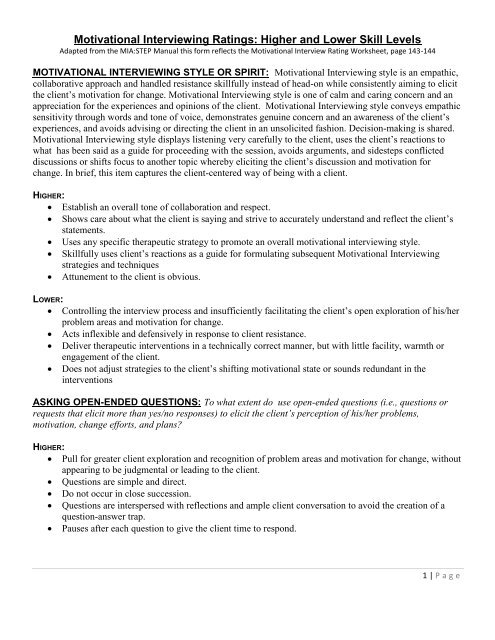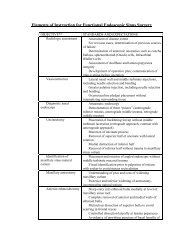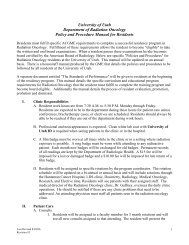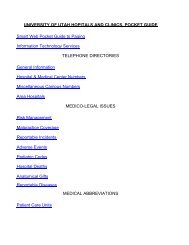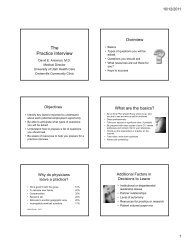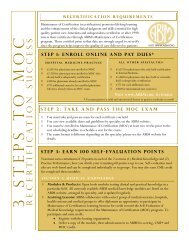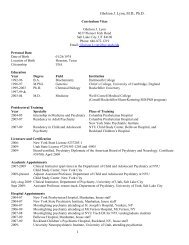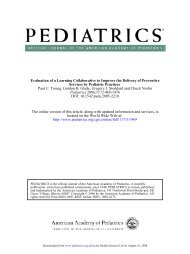Motivational Interviewing Ratings: Higher and Lower Skill Levels
Motivational Interviewing Ratings: Higher and Lower Skill Levels
Motivational Interviewing Ratings: Higher and Lower Skill Levels
Create successful ePaper yourself
Turn your PDF publications into a flip-book with our unique Google optimized e-Paper software.
<strong>Motivational</strong> <strong>Interviewing</strong> <strong>Ratings</strong>: <strong>Higher</strong> <strong>and</strong> <strong>Lower</strong> <strong>Skill</strong> <strong>Levels</strong><br />
Adapted from the MIA:STEP Manual this form reflects the <strong>Motivational</strong> Interview Rating Worksheet, page 143-144<br />
MOTIVATIONAL INTERVIEWING STYLE OR SPIRIT: <strong>Motivational</strong> <strong>Interviewing</strong> style is an empathic,<br />
collaborative approach <strong>and</strong> h<strong>and</strong>led resistance skillfully instead of head-on while consistently aiming to elicit<br />
the client’s motivation for change. <strong>Motivational</strong> <strong>Interviewing</strong> style is one of calm <strong>and</strong> caring concern <strong>and</strong> an<br />
appreciation for the experiences <strong>and</strong> opinions of the client. <strong>Motivational</strong> <strong>Interviewing</strong> style conveys empathic<br />
sensitivity through words <strong>and</strong> tone of voice, demonstrates genuine concern <strong>and</strong> an awareness of the client’s<br />
experiences, <strong>and</strong> avoids advising or directing the client in an unsolicited fashion. Decision-making is shared.<br />
<strong>Motivational</strong> <strong>Interviewing</strong> style displays listening very carefully to the client, uses the client’s reactions to<br />
what has been said as a guide for proceeding with the session, avoids arguments, <strong>and</strong> sidesteps conflicted<br />
discussions or shifts focus to another topic whereby eliciting the client’s discussion <strong>and</strong> motivation for<br />
change. In brief, this item captures the client-centered way of being with a client.<br />
HIGHER:<br />
Establish an overall tone of collaboration <strong>and</strong> respect.<br />
Shows care about what the client is saying <strong>and</strong> strive to accurately underst<strong>and</strong> <strong>and</strong> reflect the client’s<br />
statements.<br />
Uses any specific therapeutic strategy to promote an overall motivational interviewing style.<br />
<strong>Skill</strong>fully uses client’s reactions as a guide for formulating subsequent <strong>Motivational</strong> <strong>Interviewing</strong><br />
strategies <strong>and</strong> techniques<br />
Attunement to the client is obvious.<br />
LOWER:<br />
Controlling the interview process <strong>and</strong> insufficiently facilitating the client’s open exploration of his/her<br />
problem areas <strong>and</strong> motivation for change.<br />
Acts inflexible <strong>and</strong> defensively in response to client resistance.<br />
Deliver therapeutic interventions in a technically correct manner, but with little facility, warmth or<br />
engagement of the client.<br />
Does not adjust strategies to the client’s shifting motivational state or sounds redundant in the<br />
interventions<br />
ASKING OPEN-ENDED QUESTIONS: To what extent do use open-ended questions (i.e., questions or<br />
requests that elicit more than yes/no responses) to elicit the client’s perception of his/her problems,<br />
motivation, change efforts, <strong>and</strong> plans?<br />
HIGHER:<br />
Pull for greater client exploration <strong>and</strong> recognition of problem areas <strong>and</strong> motivation for change, without<br />
appearing to be judgmental or leading to the client.<br />
Questions are simple <strong>and</strong> direct.<br />
Do not occur in close succession.<br />
Questions are interspersed with reflections <strong>and</strong> ample client conversation to avoid the creation of a<br />
question-answer trap.<br />
Pauses after each question to give the client time to respond.<br />
1 | P a g e
LOWER:<br />
Poorly worded or timed or target an area not immediately relevant to the conversation.<br />
Occur in close succession, giving the conversation a halting or mechanical tone.<br />
Compound several questions into one query (e.g., “Tell me about how felt before <strong>and</strong> after got high<br />
<strong>and</strong> how that all affects r future risk for using cocaine.”)<br />
Questions lead or steer the client.<br />
Inquiries use a judgmental or sarcastic tone.<br />
do not pause sufficiently after each question to give the client time to contemplate <strong>and</strong> respond.<br />
AFFIRMATION OF STRENGTHS AND CHANGE EFFORTS: To what extent do verbally reinforce the<br />
client’s strengths, abilities, or efforts to change his/her behavior? To what extent do develop the client’s<br />
confidence by praising small steps taken in the direction of change or expressing appreciation of personal<br />
qualities in the client that might facilitate successful efforts to change?<br />
HIGHER:<br />
Affirm qualities or efforts made by the client that promote productive change or that the client might<br />
harness in future change efforts rather than being general compliments.<br />
Affirmations derived directly from the conversations.<br />
Affirmations are meaningful to the client rather than being too global or trite.<br />
appear genuine rather than merely saying something in a knee-jerk or mechanical fashion.<br />
LOWER:<br />
Not sufficiently rooted in the conversation with the client.<br />
Affirmations are not unique to the client’s description of him/herself <strong>and</strong> life circumstances or history.<br />
appear to affirm simply to maintain a client in despair or encourage a client to try to change when<br />
he/she has expressed doubt in his/her capacity to do so.<br />
Sound trite, hollow, insincere, or even condescending.<br />
MAKING REFLECTIVE STATEMENTS: To what extent did you repeat (exact words), rephrase (slight<br />
rewording), paraphrase (e.g., amplifying the thought or feeling, use of analogy, making inferences) or make<br />
reflective summary statements of what the client said?<br />
HIGHER:<br />
Accurately identify the essential meaning of what the client has said <strong>and</strong> reflect it back to the client in<br />
terms easily understood.<br />
Inflection at the end of the reflection is downward.<br />
Pauses sufficiently to give the client an opportunity to respond <strong>and</strong> to develop the conversation.<br />
Reflections are concise <strong>and</strong> clear.<br />
will have more depth. (i.e., paraphrasing thoughts or feelings in manner that effectively brings<br />
together discrepant elements or that clarify what the client meant).<br />
neatly arrange several client statements in a manner that promotes further client introspection,<br />
conversation, <strong>and</strong> motivation for change.<br />
Reflections increase the time spent talking by the client, foster a collaborative tone, <strong>and</strong> reduce client<br />
resistance.<br />
2 | P a g e
LOWER:<br />
Reflections are very inaccurate <strong>and</strong> may contribute to client feeling misunderstood.<br />
Can be too vague, complicated, or wordy.<br />
May have an upward inflection at the end <strong>and</strong> function as disguised closed-ended questions.<br />
Decrease the time spent talking by the client <strong>and</strong> may increase client’s resistance.<br />
Should not be too spread out, rather than consecutively linked over the session such that they do not<br />
increase introspection, conversation, or motivation to change.<br />
Should not be redundant or remain repetitively simple.<br />
FOSTERING A COLLABORATIVE ATMOSPHERE: To what extent do convey in words or actions that<br />
the communication is a collaborative relationship in contrast to one where are in charge? How much do<br />
emphasize the (greater) importance of the client’s own decisions, confidence, <strong>and</strong> perception of the<br />
importance of changing? To what extent do verbalize respect for the client’s autonomy <strong>and</strong> personal choice?<br />
HIGHER: <strong>Higher</strong><br />
Directly <strong>and</strong> clearly note the greater importance of the client’s perception about his/her drug use <strong>and</strong><br />
related life events in contrast to what you or significant others might think. may<br />
Underscores the collaborative nature of the interview by highlighting his or her interest in<br />
underst<strong>and</strong>ing the client’s perspective without bias.<br />
Uses direct <strong>and</strong> clear references to the client’s capacity to draw his or her own conclusions or to make<br />
personal choices about how to proceed with a plan for change rather than perceives that the client is<br />
feeling coerced by significant others can be especially effective <strong>and</strong> lead to higher <strong>Skill</strong> Level ratings.<br />
Emphasizes viable personal choices rather than choices that are unrealistic to the client also improve.<br />
LOWER:<br />
Emphasizes personal choices that do not seem realistic to the client.<br />
Uses vague, wordy, or poorly timed efforts to articulate the client’s personal control, autonomy, <strong>and</strong><br />
collaborative role in the interview reduce quality ratings.<br />
Uses advice giving in the context of seemingly collaborative statements<br />
DISCUSSING MOTIVATION TO CHANGE: To what extent did try to elicit client discussion of change<br />
(self-motivational statements) through evocative questions or comments designed to promote greater<br />
awareness/concern for the problem, recognition of the advantages of change, increased intent/optimism to<br />
change, or elaboration on a topic related to change? To what extent did discuss the stages of change, help<br />
the client develop a rating of current importance, confidence, readiness or commitment, or explore how<br />
motivation might be strengthened?<br />
HIGHER:<br />
Uses evocative questions to elicit a client’s change talk that are targeted to the client’s current level of<br />
motivation.<br />
Directly queries the client about factors that might impact intent or optimism for change.<br />
Collaboratively explores the client’s current readiness to change in depth by combining rating scales<br />
<strong>and</strong> open-ended follow-up questions <strong>and</strong> reflections that prompt the client’s arguments for change,<br />
optimism, <strong>and</strong> self-efficacy.<br />
3 | P a g e
LOWER:<br />
Elicits self-motivational statements that are inconsistent with the client’s stage of change.<br />
Client’s readiness to change become redundant.<br />
Efforts to assess readiness to change solicit client’s resistance or client argues against change<br />
DEVELOPING DISCREPANCIES: To what extent did you create or heighten the internal conflict of the<br />
client relative to his/her substance use? To what extent did you try to increase the client’s awareness of a<br />
discrepancy between where his or her life is currently versus where he or she wants it to be in the future?<br />
How much did you explore how substance use may be inconsistent with the client’s goals, values, or selfperceptions?<br />
HIGHER:<br />
Attempt to make the client aware of a discrepancy in the client’s thoughts, feelings, actions, goals or<br />
values based upon the client’s previous statements.<br />
You present the discrepancies as legitimate conflicts or mixed experiences rather than as<br />
contradictions or judgments that prove the client has a drug problem. I<br />
Interventions are clear <strong>and</strong> articulate reflections that encapsulate divergent elements of what a client<br />
has said.<br />
Integration of the client’s specific discrepant statements in well-stated terms using a supportive,<br />
nonjudgmental tone.<br />
LOWER:<br />
Highlight the opposite side of the client’s ambivalence without sufficiently counterbalancing it.<br />
Approach appears somewhat argumentative <strong>and</strong> may heighten resistance rather than develop<br />
dissonance in the client’s position.<br />
Abruptness in posing discrepancies (verbal <strong>and</strong> non-verbal) or stating discrepancies with a hint of<br />
accusation<br />
Wordy, cumbersome, or overly complex reflections of discrepant client statements<br />
EXPLORING PROS, CONS, AND AMBIVALENCE: To what extent did you address or explore the<br />
positive <strong>and</strong> negative effects or results of the client’s substance use <strong>and</strong> what might be gained <strong>and</strong> lost by<br />
abstinence or reduction in substance use? To what extent did you use decisional balancing, complete a costbenefits<br />
analysis, or develop a list of pros <strong>and</strong> cons of substance use? How much did you express appreciation<br />
for ambivalence as a normal part of the change process?<br />
HIGHER:<br />
Approach the task in a nonjudgmental, exploratory manner.<br />
Prompts the client to continue detailing dimensions of ambivalence using open-ended questions or<br />
reflections about consequences previously noted by the client.<br />
Full exploration of the pros <strong>and</strong> cons of stopping substance use versus continuing use improve quality<br />
ratings.<br />
Elicit responses from the client rather than suggest positive <strong>and</strong> negative consequences as possibilities<br />
not previously mentioned by the client.<br />
Use of summary reflections within each dimension or to compare <strong>and</strong> contrast them<br />
The specific technique of completing or reviewing a decisional balance sheet or simply discussing the<br />
pros or cons does not directly affect the <strong>Skill</strong> Level rating.<br />
4 | P a g e
LOWER:<br />
Seldom provide the client with opportunities to respond freely to the pros/cons dimensions or to more<br />
thoroughly reflect upon meaningful pros <strong>and</strong> cons to the client.<br />
Provide the client with likely pros <strong>and</strong> cons <strong>and</strong> assert this view to the client in a more closed-ended<br />
fashion.<br />
The client becomes more of a passive recipient rather than an active participant in the construction of<br />
the decisional balance or discussion of factors underlying the client’s ambivalence.<br />
List pros <strong>and</strong> cons one after the other without exploring details or the personal impact of substance use<br />
on the client’s life.<br />
When summarizing the client’s pros, cons, or ambivalence, you do not involve the client in the review<br />
<strong>and</strong> simply restate the items in a mechanical or impersonal manner.<br />
No effort is made to strategically tip the client’s motivational balance in favor of change.<br />
CHANGE PLANNING DISCUSSION: To what extent did you discuss with the client his or her readiness<br />
to prepare a change plan. To what extent did you develop a change plan with the client in a collaborative<br />
fashion? How much did you cover critical aspects of change planning such as facilitating a discussion of the<br />
client’s self-identified goals, steps for achieving those goals, supportive people available to help the client,<br />
what obstacles to the change plan might exist, <strong>and</strong> how to address impediments to change?<br />
HIGHER:<br />
Develop a detailed change plan that addresses most of the key change planning areas outlined above.<br />
Sufficient time is taken to explore each area <strong>and</strong> to encourage the client to elaborate by using openended<br />
questions <strong>and</strong> reflections.<br />
Overall, the development of the change plan is highly collaborative <strong>and</strong> serves to strengthen the<br />
client’s commitment to change.<br />
If the client expresses ambivalence during the completion of the plan, attempts are made to resolve it<br />
in the direction of change instead of pushing forward when the client may not be ready to proceed.<br />
LOWER:<br />
The change planning process is approached in a superficial, brief <strong>and</strong>/or hurried fashion.<br />
The client is not actively engaged in the change planning<br />
The plan is not individualization to the unique circumstances of the client.<br />
You take an authoritative <strong>and</strong> prescriptive tone while completing the change plan with the client.<br />
CLIENT-CENTERED PROBLEM DISCUSSION AND FEEDBACK: To what extent did you facilitate a<br />
discussion of the problems for which the client entered treatment? To what extent did you review or provide<br />
personalized, solicited feedback about the client’s substance abuse <strong>and</strong> the evidence or indications of<br />
problems in other life areas?<br />
HIGHER:<br />
Initial clinician efforts facilitate a discussion of the client’s problems may be fairly straightforward <strong>and</strong><br />
of “adequate” quality<br />
Promote the client’s further elaboration <strong>and</strong> fuller underst<strong>and</strong>ing of the presenting problems,<br />
particularly when efforts to promote problem discussion successively build upon each other.<br />
Feedback is very individualized to the client’s experiences <strong>and</strong> self-report <strong>and</strong> is presented in clear,<br />
straightforward, <strong>and</strong> supportive terms.<br />
5 | P a g e
Feedback overall is non-judgmental <strong>and</strong> use open-ended questioning, affirmations, <strong>and</strong> reflections as<br />
part of the feedback process <strong>and</strong> only offer feedback when solicited by the client or when obtaining the<br />
client’s permission to do so first.<br />
LOWER:<br />
Feedback is presented to a client in a generic way.<br />
The feedback may be unclear or presented in a judgmental fashion. The client perceives the feedback<br />
as a lecture or draws conclusions without opportunities to respond.<br />
Feedback creates the image of you as an expert <strong>and</strong> often decreases the amount of talking done by the<br />
client.<br />
Unsolicited feedback.<br />
UNSOLICTED ADVICE, DIRECTION GIVING, OR FEEDBACK: To what degree did you provide<br />
unsolicited advice, direction, or feedback to the client (e.g., offering specific, concrete suggestions for what<br />
the client should do)? To what extent was your style one of telling the client how to be successful in his/her<br />
recovery?<br />
HIGHER:<br />
Present unsolicited advice, direction, or feedback in a confident <strong>and</strong> clearly articulated manner.<br />
The advice <strong>and</strong> directions are very instructive or prescriptive to the client.<br />
While the client may “take it or leave it,” the advice leaves no doubt about your recommendations to<br />
the client.<br />
Provides a rationale to the client about the value of following the advice <strong>and</strong> direction, particularly<br />
when this rationale integrates details of the client’s life into it, improves the quality of the intervention.<br />
LOWER:<br />
Provide unclear advice, direction, or feedback or makes recommendations to the client in a tentative<br />
manner.<br />
The advice or suggestions also may not be relevant to the client <strong>and</strong>, thus, sound like a “party-line”<br />
instead of individualized to the client’s unique circumstance.<br />
EMPHASIS ON ABSTINENCE: To what extent did you present the goal of abstinence as the only<br />
legitimate goal <strong>and</strong> indicate that a controlled use goal was not acceptable or completely unrealistic? How<br />
much did you seek to impose his/her judgment about the goals of abstinence <strong>and</strong> emphasize that abstinence<br />
was considered to be the necessary st<strong>and</strong>ard for judging any improvement during treatment?<br />
HIGHER:<br />
Emphasis on abstinence occurs when you provides a clear, persuasive, <strong>and</strong> confident rationale for<br />
abstinence to the client <strong>and</strong> attempts to compel the client to adopt total abstinence as the central<br />
treatment goal.<br />
Message is loud <strong>and</strong> clear <strong>and</strong> makes a point through the client’s own substance use history, clinical<br />
examples or anecdotes, or references to treatment approaches <strong>and</strong> clinical consensus that emphasizes<br />
total abstinence.<br />
6 | P a g e
LOWER:<br />
Appears to be giving “lip service” to total abstinence without conviction or a convincing rationale.<br />
The emphasis, while mentioned, is downplayed or casually suggested rather than at the forefront of<br />
your approach to substance abuse treatment.<br />
The rationale is more rooted in an administrative policy rather than based on your philosophical<br />
conviction or the client’s reported pattern of uncontrolled use.<br />
DIRECT CONFRONTATION OF CLIENT: To what extent did you directly confront the client about his or<br />
her failure to acknowledge problems or concerns related to substance use <strong>and</strong> other behavioral difficulties<br />
(e.g., psychiatric symptoms, lying, treatment noncompliance)? To what extent did you directly confront the<br />
client about not taking steps to try to change identified problem areas<br />
HIGHER:<br />
Use of confrontational strategies occurs when you are clear, concise, <strong>and</strong> firm with the client about the<br />
client’s defensiveness in talking about his/ her substance use <strong>and</strong> related areas as problems.<br />
Persistence in pointing out the client’s denial <strong>and</strong> tries to use the confrontation to get the client to<br />
acknowledge the problem <strong>and</strong> deal with it in more realistic terms, even if the client initially becomes<br />
more defensive.<br />
The client feels compelled to change his behavior as a result of the discussion rather than to change as<br />
a result of his/her choices.<br />
LOWER:<br />
Confrontational strategies insufficiently challenge the client’s distortions about his/her substance use<br />
<strong>and</strong> related life circumstances.<br />
Rather than persisting in confronting a resistant client, you retreat from the confrontation <strong>and</strong> may<br />
adopt less confrontational approaches to resolve the resistance.<br />
Reference is made to the client’s denial or defensiveness without effort to “break through” it is lower<br />
quality.<br />
Confrontational statements made have content that is “confrontational,” but lacks the persistent or<br />
perhaps insistent confrontational style at times necessary to change client behavior.<br />
POWERLESSNESS AND LOSS OF CONTROL: To what extent did you emphasize the concept of<br />
powerlessness over addiction as a disease <strong>and</strong> the importance of the client’s belief in this for successful<br />
sobriety? To what extent did you express the view that all substance use represents a loss of control or that<br />
the client’s life is unmanageable when s/ he uses substances?<br />
HIGHER:<br />
Provide a clear <strong>and</strong> convincing discussion of the disease concept of addiction.<br />
This discussion would involve a thorough detailing of how drug <strong>and</strong> alcohol addiction is a primary,<br />
progressive, <strong>and</strong> chronic process that ultimately severely damages a person’s life in all areas <strong>and</strong>, if<br />
left unchecked, will lead to “jails, institutions, <strong>and</strong> death.”<br />
Directly apply the principles to the client’s history <strong>and</strong> presenting problems.<br />
Persuasively “makes the case” that the client is powerless over addiction <strong>and</strong> inevitably will lose<br />
control of his/her life.<br />
7 | P a g e
LOWER:<br />
The disease concept of addiction, powerlessness, or loss of control is merely mention (even<br />
repeatedly) without really explaining what these principles mean or the implications of them for the<br />
client.<br />
The presentation of the concepts of powerlessness or loss of control sounds mechanical, rigid <strong>and</strong><br />
untied to the nature <strong>and</strong> circumstances of the client’s substance use problem.<br />
ASSERTING AUTHORITY: To what extent did you verbalize clear conclusions or decisions about what<br />
course of counseling would be best for the client? How much did you warn that recovery would be impeded<br />
unless the client followed certain steps or guidelines in treatment? To what extent did you try to lecture the<br />
client about “what works” about treatment or the likelihood of poor outcome if the client tried to do his/her<br />
own treatment? To what extent did you refer to his or her own experiences, knowledge, <strong>and</strong> expertise to<br />
highlight the points made to the client?<br />
HIGHER:<br />
Provide directives <strong>and</strong> recommendations with confidence <strong>and</strong> clarity.<br />
Reference scientific knowledge base, clinical experience, or personal recovery to fortify therapeutic<br />
authority during the session <strong>and</strong> to underscore the need for the client to follow your directions.<br />
More prescriptive tone aims to promote the client’s compliance with your recommendations <strong>and</strong><br />
improve the client’s treatment outcomes rather than merely to assert power <strong>and</strong> control over the client.<br />
LOWER:<br />
Assertion of authority is softened by seeking the client’s input, guidance, or approval for what was<br />
said.<br />
The initially prescriptive tone yields to a collaborative one.<br />
The client has excessive input into the development of the treatment plan, despite the client’s<br />
potentially poor judgment about what might be best for him or her.<br />
CLOSED-ENDED QUESTIONS: To what extent did you ask questions that could be answered with a yes<br />
or no response or that sought after specific details or information from the client?<br />
HIGHER:<br />
Closed-ended questions pull the client to answer the question specifically asked rather than giving the<br />
client leeway to elaborate on a topic or area.<br />
They occur in close succession as they follow-up on one another.<br />
When performed well, closed-ended questions establish that you are in control of the session <strong>and</strong> in<br />
the role of the expert trying to discern information important for clinical assessment/evaluation <strong>and</strong><br />
treatment.<br />
Are very clear <strong>and</strong> direct; thereby minimizing any confusion a client may have about what you has<br />
asked <strong>and</strong> wants to know.<br />
LOWER:<br />
Overly complex due to asking the client several matters in one question or stringing together many<br />
closed-ended questions before permitting the client to answer them.<br />
The specificity of the client’s answer may be lost in the client’s inability to recall the question or in<br />
considering what part of the question to answer first.<br />
8 | P a g e


